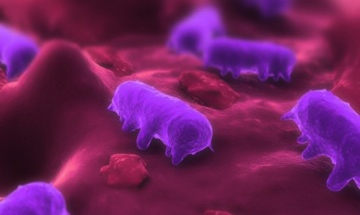
Salmonella: a tricky bug to remove from a plant
Food in Canada
Food Safety Meat &Poultry disinfectant salmonella tickerA study from Ireland finds that once Salmonella enters a food processing plant and has a chance to establish itself, the biofilms are nearly impossible to remove

Galway, Ireland – A researcher at the National University of Ireland has found that once Salmonella is in a food processing plant, it’s a tricky bug to remove.
Microbiologist Dr. Mary Corcoran attempted to kill Salmonella biofilms on a variety of hard surfaces, using three types of disinfectant.
But if Salmonella has established itself for seven days, three disinfectants couldn’t kill it, even by soaking the Salmonella in disinfectant for an hour and a half.
The three disinfectants she used were sodium hypochlorite (household bleach), sodium hydroxide, and benzalkonium chloride.
Corcoran’s research found that all of the types of Salmonella studied were able to adopt the specialized biofilm lifestyle on all of the surfaces looked at. These included glass, stainless steel, glazed tile, concrete and plastic.
The study showed that the biofilm of Salmonella gets more dense over time, and becomes more firmly attached to the surface.
Corcoran says her work serves as a warning to food processors in particular highlighting that once Salmonella gets into a food processing facility and has an opportunity to form a biofilm on surfaces, it’s likely to be extraordinarily difficult, if not impossible, to kill it.
“Food processing facilities must take strict care to keep Salmonella out of the clean areas where cooked foods get further processing and packaged, and ask whether disinfectants that are promoted as killing various types of bacteria are really as effective as claimed,” says Corcoran.
Her research was prompted by the Salmonella outbreak in Europe in which more than 160 people in 10 countries developed gastroenteritis from the Salmonella Agona strain of Salmonella. The outbreak was traced back to meat from a major food-processing facility.
Corcoran explains that the outbreak entered into the environment in the part of the facility where meat that was already cooked was being handled, and it had survived and contaminated the cooked meat.
Corcoran adds that she was interested in finding out if Salmonella might have something special about it that makes it better at surviving in the environment of a food processing facility.
So she says “we asked: was it better at forming a dense biofilm, or was it more resistant to disinfectants than other Salmonella? We discovered it was not.”
The research shows that a lot of the time, says Corcoran, the disinfectant may add very little, if anything, to good cleaning and appropriate food handling practices and that there is a need for more research to define better methods for killing Salmonella biofilm.
Print this page